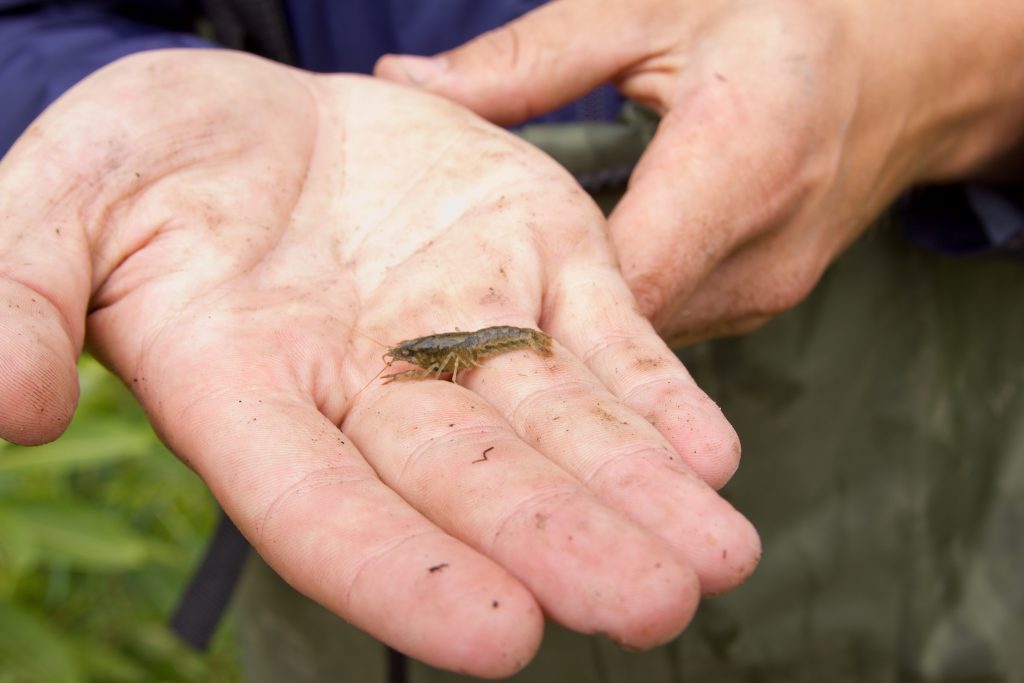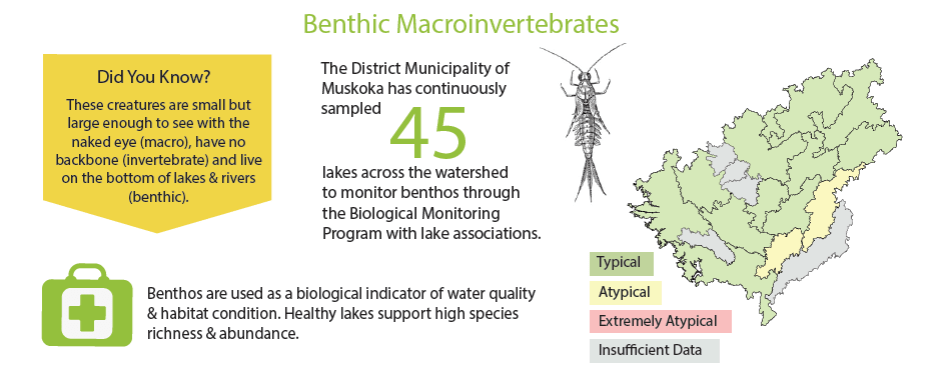Monthly Archives: June 2018
Without bugs, much of the life in Muskoka’s lakes would diminish

Muskoka Watershed Council’s 2018 Muskoka Watershed Report Card was launched in July. It features 8 indicators of environmental health: total phosphorus, calcium concentrations in lakes, benthic macroinvertebrates, species at risk, invasive species, climate change, interior forest and fragmentation.
As the warm weather arrives; foliage begins to bloom, the birds start chirping, and of course, the bugs become fierce.
Muskoka has some of the most beautiful lakes and rivers in the world, and at the bottom of these lakes are bugs — also known as benthic macroinvertebrates (or benthos). These bottom-dwelling critters, which consist of insect larvae, beetles, snails, clams, worms, dragonflies, mosquitoes and mayflies, can be found attached to rocks, logs, sticks and vegetation, or burrowed into the sediments.
What exactly does the name “benthic macroinvertebrate” mean, anyways? Let’s break it down: benthic = bottom, macro = small (but large enough to see with the naked eye) and invertebrate = without a backbone.
These bugs are an amazing biological indicator of lake health. They provide information on our lakes because they are sensitive to changes in water quality. Too many or too little of a certain species can indicate the quality of water and the surrounding aquatic habitat. They also spend the majority of their lives in the same area of water, they are easy to sample, and different species have different tolerances to disturbances like pollution. So, when samples are collected, we can tell what the biological conditions of the water are like by the presence of absence of various benthic species. They are also low on the food chain, providing food to many fish and larger benthos species.

Crayfish like this one are a type of benthic macroinvertebrate.
“When I’m sampling and lift my net out of the water, I get excited about taking my first look into the net. I’m looking for bugs like caddisflies, dragonflies and mayflies because they indicate good water quality, they’re pollution or disturbance sensitive”, says Cassie Weston, the Muskoka Watershed Council Report Card intern and a former biotech summer student with the District of Muskoka. “It’s cool to not only see the biological communities under water, but to also see how surprised the various volunteers are who are helping me sample when I show them the bugs I collected right off their dock. Many of them have no idea of the diversity of life that exists right under their toes when they go for a dip in the lake”.
Next time you sink your toes in a lake, think of these little critters as lake or stream keepers — without these critters, much of the life in our lakes as we know it would diminish.
Learn more about the health of your watershed and what you can do to maintain and enhance it! Visit the Muskoka Watershed Council website at www.muskokawatershed.org for the Muskoka Watershed Report Card.
Measuring a Healthy Muskoka Watershed

How is our changing climate impacting Muskoka? What does calcium have to do with Muskoka’s environmental health? And what the heck are benthic macroinvertebrates?On July 19, Muskoka Watershed Council will be answering these questions and many more through the release of its fifth Muskoka Watershed Report Card. Following its launch at Gravenhurst’s Discovery Centre, MWC’s interactive, online report card will be available at www.muskokawatershed.org.
Muskoka Watershed Council’s Report Card is a science-based evaluation of the health of our watershed using several environmental indicators. These indicators tell us something about particular aspects of that health — sort of like using blood pressure, pulse rate, temperature, weight and waist size as indicators of human health.
Produced every four years, using local, regional and citizen-scientist data and guided by expert scientific advisers, the Muskoka Watershed Council’s Report Card complies thousands of measurements into a simple and meaningful, interactive online report. The report card provides an “environmental snapshot” that will inform our own understanding of the watershed where we live, work and play, and will offer ideas and actions that individuals can undertake to protect it.
In 2018, four indicators will measure the health of the watershed and four indicators will consider potential threats to its health. Total phosphorus and calcium concentrations in lakes, benthic macroinvertebrates (or “bugs in the mud”) and the percentage of interior forest habitat will be reported on in the health indicator category. Threat indicators include climate change, invasive species and fragmentation, with a spotlight on species at risk. Each indicator is accompanied by a local initiative or citizen science program that you can get involved with, including the Lake Partner Program, the district’s benthic monitoring program, and becoming a PhragBuster with Georgian Bay Forever.
Species at risk are plants and animals that have been examined and determined to be in imminent risk of extinction within Ontario. Of the hundreds of species listed, at least 40 are known to occur in Muskoka, including the whippoorwill, eastern hognose snake, Blanding’s turtle, lake sturgeon, little brown bat, butternut and the rust-patched bumblebee.
That these species thrive here is wonderful, and keeping them here is a worthwhile goal. While it is known that many of these at-risk species are here, we do not know every place in Muskoka where they may be found. But we do know that in Muskoka, there are patches of habitat that would be suitable for each of them, and it turns out some parts of Muskoka provide a greater amount of suitable habitat for more species at risk than others. By taking more care in places that might be home to species at risk we can enhance the chances that these species will continue to thrive here.
Dive deeper into the health of your Muskoka watershed, and look for the report card on July 19, at www.muskokawatershed.org.

